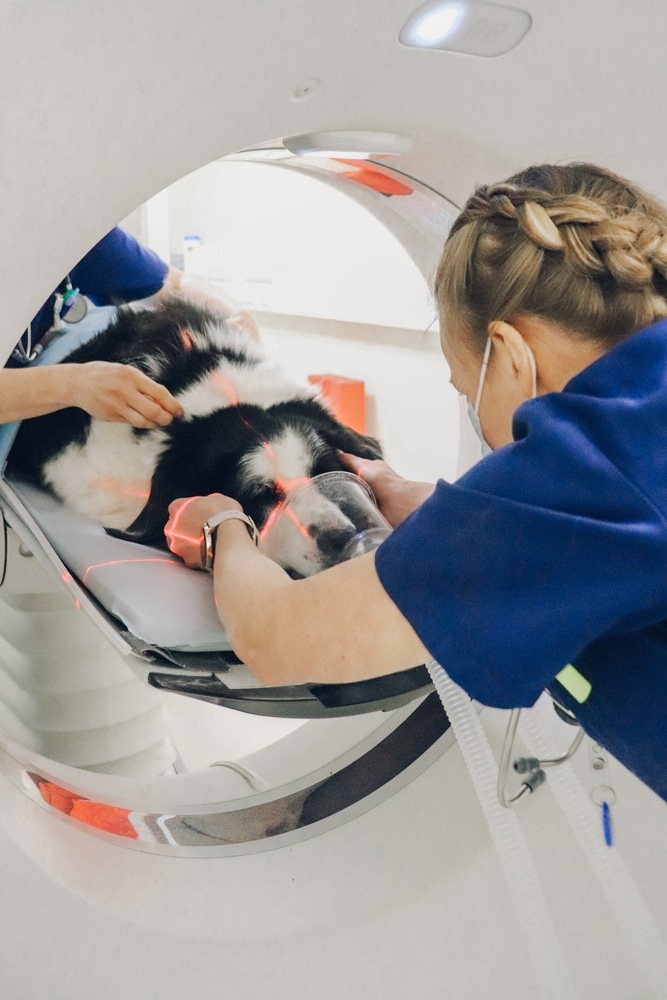Artificial Intelligence (AI) has become integral to several industries over the past few years, streamlining the way we work. So, unsurprisingly, AI in veterinary medicine is increasingly common. With the adoption of AI technology, veterinary practices are seeing revolutionary changes that improve accuracy and optimize administrative functions, leading to an enhanced patient experience.
As AI continues to evolve, its impact on veterinary care grows, promising a future of enhanced, efficient, and personalized services. From early disease detection to automating routine tasks, AI is rapidly transforming how veterinarians diagnose, treat, and communicate with clients, allowing stronger connections between vets and their patients with fewer organizational barriers to cause unnecessary hassle.
The Increasing Adoption of AI in Veterinary Medicine
AI is spreading like wildfire throughout veterinary medicine. Statistics show a growing trend of AI adoption rates across the industry, with 39.2% of veterinary professionals surveyed reporting regular use of AI in their practice. This number is steadily growing—many clinics now incorporate AI-powered tools into their daily workflows, signaling an exciting shift toward more advanced and efficient care.
So far, veterinary professionals are embracing AI as a powerful tool to advance care and practice operations. There’s an overall optimism about AI’s potential, with many in the industry curious about how this technology can be implemented quickly in various veterinary practice operations.
AI applications are also extending beyond general practice and into specialized areas. We’re starting to see its reach in radiology and soft tissue surgery, including minimally invasive procedures. Beyond this, AI is extending into the operations side of veterinary medicine with improvements to how we approach practice management.
How is AI Currently Used in Veterinary Medicine?
As much as we want AI adoption to be simple, its use in veterinary medicine is still rather complex. Plenty of concerns surround whether AI will replace jobs or introduce opportunities for error when used for diagnostics. However, its role in optimizing clinic efficiency is far-reaching.
AI isn’t waiting for human buy-in, though. Tools are currently being researched for even more applications, such as genetic testing, which would allow veterinarians to better understand inherited diseases and provide more accurate genetic counseling.
Here are more examples of how AI is already being used to enhance veterinary practices and operations:
1. AI-generated SOAP Notes and AI Scribes
One of the most practical uses of AI in veterinary medicine is the generation of Subjective, Objective, Assessment, Plan (SOAP) notes. These notes are primary documents that provide clear communication between veterinarians, pet owners, and other staff members.
AI-powered scribes can automate this process, reducing the time spent on documentation and improving the accuracy of the information. These changes would allow veterinarians to focus more on patient care while ensuring the information is always current and thorough.
2. Early Detection and Diagnosis
At its core, AI can analyze vast amounts of data through machine learning algorithms, which means it excels in pattern recognition. This skill allows AI to identify some animal illnesses early, leading to quicker intervention and improved recovery rates, significantly benefiting patient outcomes.
Whether detecting diseases in their infancy or recognizing subtle symptoms that may go unnoticed by humans, AI can supplement veterinary expertise by assisting in diagnosing potential health issues faster and with increased accuracy.
3. Radiology Image Analysis

Radiology plays a pivotal role in veterinary medicine, so it makes sense that AI is enhancing this area by providing advanced image analysis. Using its core skills, AI veterinary software can assist radiologists by analyzing X-rays, MRIs, and other imaging techniques to identify even the most seemingly benign abnormalities. These tools improve image quality and provide more accurate readings, allowing veterinary care teams to provide more precise diagnoses with better treatment decisions.
4. Behavior Monitoring
AI technology can be applied to monitor pet behavior over time. These algorithms compare a pet’s current behavior with established norms, providing valuable insights into the animal’s health and well-being. By analyzing previous medical data and tracking changes in behavior, AI can assist veterinarians in diagnosing conditions such as anxiety or aggression, and if these might be caused by underlying pain.
5. Analyzing Research for Disease and Drug Trials
AI excels in handling large datasets, making it an invaluable tool for researchers in the veterinary field. When conducting drug trials or studying diseases, AI can process enormous amounts of data, identifying even the smallest patterns that would be difficult or impossible for humans to detect. This capability accelerates research timelines and improves the accuracy of results, opening the door for better drug development.
6. Personalizing Treatment
Personalized treatment plans are becoming a reality thanks to AI. AI veterinary software can provide veterinarians with customized treatment options after analyzing a pet’s medical history and current symptoms. This tailored approach ensures that each animal receives the most effective care based on its unique needs, improving recovery times and overall health outcomes.
7. Automating Client Communication
Beyond the exam room, AI-powered virtual assistants and chatbots are becoming increasingly important in customer communication. These tools are already widely used, coming in the form of answering services, online appointment scheduling, and even sending reminders and updates to pet owners. Automating these internal processes streamlines communication and ensures that clients are always informed, which can be seen in improvements to the overall customer experience.
8. Streamlining Admin Tasks
Administrative tasks, like scheduling and billing, can be time-consuming and prone to human error. AI in veterinary medicine can automate these tasks, saving clinic staff time and even reducing mistakes caused by human error. By handling routine administrative work, AI allows veterinary staff to focus on patient care, reducing stress on your care teams.
What are the Benefits of Using AI Veterinary Software and Tools?
There are several key benefits to implementing AI in veterinary practices:
- Better Care Outcomes: With AI managing routine tasks, the risk of human error is reduced, leading to more accurate diagnoses and better treatment outcomes.
- Cost Reduction: By automating tasks, AI can reduce the need for manual labor, leading to cost savings for the practice.
- Enhanced Client Experience: AI-driven communication tools allow pet owners to receive instant responses and information, increasing their confidence in their pets’ care.
- Improved Diagnosis and Decision-Making: AI-powered diagnostic tools can process data quickly and accurately, providing veterinarians and pet owners with the information they need to make informed treatment decisions.
- Increased Efficiency: AI streamlines internal processes, allowing veterinary teams to focus on high-priority tasks and improving overall workflow.

How to Handle AI Adoption in Your Veterinary Practice
Adopting AI in a veterinary practice requires some organizational prowess, especially in clinics with established procedures. Introducing new technologies can be met with resistance, particularly from individuals who may be less familiar with the latest innovations and their benefits.
To manage this transition, it’s essential to provide adequate training and messaging about its use, ensure clear communication about the benefits of AI, and address any concerns upfront. Engaging all team members in the process can help smooth the integration and provide a positive outcome for everyone involved.
Enhance Your Practice with AI-Powered Veterinary Software from DaySmart Vet
For veterinary practices looking to integrate AI into their operations, DaySmart Vet offers a comprehensive solution. Trusted by over 6,000 veterinary professionals, DaySmart’s cloud-based software streamlines practice management, allowing your team to focus on where their skills are best utilized.
By leveraging AI-powered tools like AI Scribe features, which allow for detailed SOAP Note dictation, DaySmart Vet can help veterinary teams work smarter, not harder, enhancing every aspect of care from diagnosis to client communication. Look for our new AI features coming soon!
Ready to elevate your veterinary practice with the power of AI? Book your demo today and see how DaySmart Vet can transform your practice.

